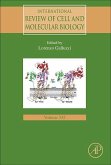Camillo Peracchia (Volume ed.)
Gap Junctions: Molecular Basis of Cell Communication in Health and Disease
Volume 49
Herausgegeben:Benos, Dale J.; Peracchia, Camillo
Camillo Peracchia (Volume ed.)
Gap Junctions: Molecular Basis of Cell Communication in Health and Disease
Volume 49
Herausgegeben:Benos, Dale J.; Peracchia, Camillo
- Broschiertes Buch
- Merkliste
- Auf die Merkliste
- Bewerten Bewerten
- Teilen
- Produkt teilen
- Produkterinnerung
- Produkterinnerung
Since the first gap junction protein (connexin) was cloned over a decade ago, more than a dozen connexin genes have been cloned. Consequently, a wealth of information on the molecular basis of gap junctional communication has been accumulated. This book pays tribute to this exciting era in the history of cell communication research by documenting the great strides made in this field as a result of the merging of biophysics and molecular biology, two of the most powerful approaches to studying the molecular basis of membrane channel behavior. Twenty-eight comprehensive chapters, authored by…mehr
Andere Kunden interessierten sich auch für
![Regulated Cell Death Part B Regulated Cell Death Part B]() Regulated Cell Death Part B113,99 €
Regulated Cell Death Part B113,99 €![International Review of Cell and Molecular Biology International Review of Cell and Molecular Biology]() International Review of Cell and Molecular Biology150,99 €
International Review of Cell and Molecular Biology150,99 €![International Review of Cell and Molecular Biology International Review of Cell and Molecular Biology]() International Review of Cell and Molecular Biology137,99 €
International Review of Cell and Molecular Biology137,99 €![International Review of Cell and Molecular Biology International Review of Cell and Molecular Biology]() International Review of Cell and Molecular Biology142,99 €
International Review of Cell and Molecular Biology142,99 €![International Review of Cell and Molecular Biology International Review of Cell and Molecular Biology]() International Review of Cell and Molecular Biology142,99 €
International Review of Cell and Molecular Biology142,99 €![International Review of Cell and Molecular Biology International Review of Cell and Molecular Biology]() International Review of Cell and Molecular Biology142,99 €
International Review of Cell and Molecular Biology142,99 €![RNA Modification RNA Modification]() RNA Modification84,99 €
RNA Modification84,99 €-
-
-
Since the first gap junction protein (connexin) was cloned over a decade ago, more than a dozen connexin genes have been cloned. Consequently, a wealth of information on the molecular basis of gap junctional communication has been accumulated. This book pays tribute to this exciting era in the history of cell communication research by documenting the great strides made in this field as a result of the merging of biophysics and molecular biology, two of the most powerful approaches to studying the molecular basis of membrane channel behavior. Twenty-eight comprehensive chapters, authored by internationally recognized leaders in the field, discuss the biophysical, physiological, and molecular characteristics of cell-to-cell communication via gap junctions. Key aspects of molecular structure, formation, gating, conductance, and permeability of vertebrate and invertebrate gap junction channels are highlighted. In addition, a number of chapters focus on recent discoveries that implicate connexin mutations and alterations of gap junctional communication in the pathogenesis of several diseases, including the X-linked Charcot-Marie-Tooth demyelinating disease, some forms of inherited sensorineural deafness, malignant transformation, cardiac malformations and arrhythmia, eye lens cataract, and Chagas disease.
Produktdetails
- Produktdetails
- Current Topics in Membranes Volume 49
- Verlag: Academic Press / Elsevier Science & Technology
- Artikelnr. des Verlages: C2009-0-02217-X
- 2000.
- Seitenzahl: 670
- Erscheinungstermin: 14. Dezember 1999
- Englisch
- Abmessung: 227mm x 151mm x 26mm
- Gewicht: 880g
- ISBN-13: 9780125506458
- ISBN-10: 0125506457
- Artikelnr.: 20989317
- Current Topics in Membranes Volume 49
- Verlag: Academic Press / Elsevier Science & Technology
- Artikelnr. des Verlages: C2009-0-02217-X
- 2000.
- Seitenzahl: 670
- Erscheinungstermin: 14. Dezember 1999
- Englisch
- Abmessung: 227mm x 151mm x 26mm
- Gewicht: 880g
- ISBN-13: 9780125506458
- ISBN-10: 0125506457
- Artikelnr.: 20989317
Camillo Peracchia is a Professor Emeritus of Physiology and Pharmacology at the University of Rochester, School of Medicine. His research has focused on the structure and chemical regulation of cell-to-cell communication via gap junction channels and on the direct role of calmodulin in gap junction channel gating. Continuously funded by NIH for almost four decades, he has published over a hundred papers, authored a book and edited three others. He was an invited speaker at over forty international congresses and symposia, and has been Associate Editor of the Journal of Neurocytology. In 1994 he was elected Honorary Member of the "Societá di Medicina e Scienze Naturali? (University of Parma, Italy). He has served as Regular Member of the Cell Biology and Physiology Study Section (CBY-1, NIH, 1990-94), and is a National Reviewers Reserve (NIH, 1994-present). He is a member of the American Society for Cell Biology and the Biophysical Society. In March 2017 he received a Lifetime Achi
evement Award from Marquis Who's Who. He has taught Respiratory Physiology to medical students and Cell Biology to graduate students. In recognition of his teaching activity, he was awarded the Manuel D. Goldman Prize (1998), the Edward F. Adolph Medal (2004), and five commendations (1995, 1996, 1999, 2002, 2005).
evement Award from Marquis Who's Who. He has taught Respiratory Physiology to medical students and Cell Biology to graduate students. In recognition of his teaching activity, he was awarded the Manuel D. Goldman Prize (1998), the Edward F. Adolph Medal (2004), and five commendations (1995, 1996, 1999, 2002, 2005).
Channel Structure, Assembly, and Degradation:
Gap Junction Structure: New Structures and New Insights, G. Sosinsky.
Degradation of Gap Junctions and Connnexins, J.G. Laing and E.C. Beyer.
Channel Forms, Permeability, and Conductance:
Homotypic, Heterotypic, and Heteromeric Gap Junction Channels, P.R. Brink, V. Valiunas, and G.J. Christ.
Heteromultimeric Gap Junction Channels and Cardiac Disease, S. Elenes and A.P. Moreno.
Ion Permeation through Connexin Gap Junction Channels: Effects on Conductance and Selectivity, R.D. Veenstra.
Phosphorylation of Connexins: Consequences for Permeability, Conductance, and Kinetics of Gap Junction Channels, H.J. Jongsma, H.V.M. van Rijen, B.R. Kwak, and M. Chanson.
Intercellular Calcium Wave Communication via Gap Junction-Dependent and -Independent Mechanisms, E. Scemes, S.O. Suadicani, and D.C. Spray.
Voltage Grating:
Membrane Potential Dependence of Gap Junctions in Vertebrates, L.C. Barrio, A. Revilla, J.M. Goméz-Hernandez, M. de Miguel, and G. González..
A Reexamination of Calcium Effects on Gap Junctions in Heart Myocytes, B. Delage and J. Délèze.
Chemical Grating:
Distinct Behaviors of Chemical- and Voltage-Sensitive Gates of Gap Junction Channel, F.F. Bukauskas and C. Peracchia.
A Molecular Model for the Chemical Regulation of Connexin43 Channels: The "Ball-and-Chain" Hypothesis, M. Delmar, K. Stergiopoulos, Nobuo Homma, G. Calero, G. Morley, J.F. Ek-Vitorin, and S.M. Taffet.
Mechanistic Differences between Chemical and Electrical Gating of Gap Junctions, I.M. Skerrett, J.F. Smith, and B.J. Nicholson.
Behavior of Chemical- and Slow Voltage-Sensitive Gates of Connexin Channels: the "Cork" Gating Hypothesis, C. Peracchia, X.G. Wang, and L.L. Peracchia.
Molecular Determinants of Voltage Gating of Gap Junctions Formed by Connexin32 and 26, T.A. Bargiello, S. Oh, Y. Ri, P.E. Purnick, and V.K. Verselis.
Regulation of Connexin43 by Tyrosine Protein Kinases, A.F. Lau, B. Warn-Cramer, and R. Lin.
Gating of Gap Junction Channels and Hemichannels in the Lens: A Role in Cataract?, R. Eckert, P. Donaldson, J. Lin, J. Bond, C. Green, R. Merriman-Smith, M. Tunstall, and J. Kistler.
Hemichannels:
Biophysical Properties of Hemi-Gap-Junctional Channels Expressed in XenopusOocytes, L. Ebihara and J. Pal.
Properties of Connexin50 Hemichannels Expressed in Xenopus laevisOocytes, S. Eskandari and G.A. Zampighi.
Invertebrate Gap Junctions:
Gap Junction Communication in Invertebrates: The Innexin Gene Family, P. Phelan.
Diseases Based on Defects of Cell Communication:
Hereditary Human Diseases Caused by Connexin Mutations, M.V.L. Bennett and C.K. Abrams.
Trafficking and Targeting of Connexin32 Mutations to Gap Junctions in Charcot-Marie-Tooth X-Linked Disease, P.E.M. Martin and W.H. Evans.
Molecular Basis of Deafness Due to Mutations in the Connexin26 Gene (GJB2), X. Estivill and R. Rabionet.
"Negative: Physiology: What Connexin-Deficient Mice Reveal about the Functional Roles of Individual Gap Junction Proteins, D.C. Spray, T. Kojima, E. Scemes, S.O. Suadicani, Y. Gao, S. Zhao, and A. Fort.
Role of Gap Junctions in Cellular Growth Control and Neoplasia: Evidence and Mechanisms, R.J. Ruch.
Gap Junctions in Inflammatory Responses: Connexins, Regulation, and Possible Functional Roles, J.C. Sáez, roberto Araya, M.C. Branes, M. Concha, J.E. Contreras, E.A. Eugenín, A.D. Martínez, F. Palisson, and M.A. Sepúlveda.
Cx43 (a<->1) Gap Junctions in Cardiac Development and Disease, R.G. Gourdie and C.W. Lo.
Gap Junctional Communication in the Failing Heart, W.C. De Mello.
Gap Junctions Are Specifically Disrupted by Trypanosoma cruzi
Gap Junction Structure: New Structures and New Insights, G. Sosinsky.
Degradation of Gap Junctions and Connnexins, J.G. Laing and E.C. Beyer.
Channel Forms, Permeability, and Conductance:
Homotypic, Heterotypic, and Heteromeric Gap Junction Channels, P.R. Brink, V. Valiunas, and G.J. Christ.
Heteromultimeric Gap Junction Channels and Cardiac Disease, S. Elenes and A.P. Moreno.
Ion Permeation through Connexin Gap Junction Channels: Effects on Conductance and Selectivity, R.D. Veenstra.
Phosphorylation of Connexins: Consequences for Permeability, Conductance, and Kinetics of Gap Junction Channels, H.J. Jongsma, H.V.M. van Rijen, B.R. Kwak, and M. Chanson.
Intercellular Calcium Wave Communication via Gap Junction-Dependent and -Independent Mechanisms, E. Scemes, S.O. Suadicani, and D.C. Spray.
Voltage Grating:
Membrane Potential Dependence of Gap Junctions in Vertebrates, L.C. Barrio, A. Revilla, J.M. Goméz-Hernandez, M. de Miguel, and G. González..
A Reexamination of Calcium Effects on Gap Junctions in Heart Myocytes, B. Delage and J. Délèze.
Chemical Grating:
Distinct Behaviors of Chemical- and Voltage-Sensitive Gates of Gap Junction Channel, F.F. Bukauskas and C. Peracchia.
A Molecular Model for the Chemical Regulation of Connexin43 Channels: The "Ball-and-Chain" Hypothesis, M. Delmar, K. Stergiopoulos, Nobuo Homma, G. Calero, G. Morley, J.F. Ek-Vitorin, and S.M. Taffet.
Mechanistic Differences between Chemical and Electrical Gating of Gap Junctions, I.M. Skerrett, J.F. Smith, and B.J. Nicholson.
Behavior of Chemical- and Slow Voltage-Sensitive Gates of Connexin Channels: the "Cork" Gating Hypothesis, C. Peracchia, X.G. Wang, and L.L. Peracchia.
Molecular Determinants of Voltage Gating of Gap Junctions Formed by Connexin32 and 26, T.A. Bargiello, S. Oh, Y. Ri, P.E. Purnick, and V.K. Verselis.
Regulation of Connexin43 by Tyrosine Protein Kinases, A.F. Lau, B. Warn-Cramer, and R. Lin.
Gating of Gap Junction Channels and Hemichannels in the Lens: A Role in Cataract?, R. Eckert, P. Donaldson, J. Lin, J. Bond, C. Green, R. Merriman-Smith, M. Tunstall, and J. Kistler.
Hemichannels:
Biophysical Properties of Hemi-Gap-Junctional Channels Expressed in XenopusOocytes, L. Ebihara and J. Pal.
Properties of Connexin50 Hemichannels Expressed in Xenopus laevisOocytes, S. Eskandari and G.A. Zampighi.
Invertebrate Gap Junctions:
Gap Junction Communication in Invertebrates: The Innexin Gene Family, P. Phelan.
Diseases Based on Defects of Cell Communication:
Hereditary Human Diseases Caused by Connexin Mutations, M.V.L. Bennett and C.K. Abrams.
Trafficking and Targeting of Connexin32 Mutations to Gap Junctions in Charcot-Marie-Tooth X-Linked Disease, P.E.M. Martin and W.H. Evans.
Molecular Basis of Deafness Due to Mutations in the Connexin26 Gene (GJB2), X. Estivill and R. Rabionet.
"Negative: Physiology: What Connexin-Deficient Mice Reveal about the Functional Roles of Individual Gap Junction Proteins, D.C. Spray, T. Kojima, E. Scemes, S.O. Suadicani, Y. Gao, S. Zhao, and A. Fort.
Role of Gap Junctions in Cellular Growth Control and Neoplasia: Evidence and Mechanisms, R.J. Ruch.
Gap Junctions in Inflammatory Responses: Connexins, Regulation, and Possible Functional Roles, J.C. Sáez, roberto Araya, M.C. Branes, M. Concha, J.E. Contreras, E.A. Eugenín, A.D. Martínez, F. Palisson, and M.A. Sepúlveda.
Cx43 (a<->1) Gap Junctions in Cardiac Development and Disease, R.G. Gourdie and C.W. Lo.
Gap Junctional Communication in the Failing Heart, W.C. De Mello.
Gap Junctions Are Specifically Disrupted by Trypanosoma cruzi
Channel Structure, Assembly, and Degradation:
Gap Junction Structure: New Structures and New Insights, G. Sosinsky.
Degradation of Gap Junctions and Connnexins, J.G. Laing and E.C. Beyer.
Channel Forms, Permeability, and Conductance:
Homotypic, Heterotypic, and Heteromeric Gap Junction Channels, P.R. Brink, V. Valiunas, and G.J. Christ.
Heteromultimeric Gap Junction Channels and Cardiac Disease, S. Elenes and A.P. Moreno.
Ion Permeation through Connexin Gap Junction Channels: Effects on Conductance and Selectivity, R.D. Veenstra.
Phosphorylation of Connexins: Consequences for Permeability, Conductance, and Kinetics of Gap Junction Channels, H.J. Jongsma, H.V.M. van Rijen, B.R. Kwak, and M. Chanson.
Intercellular Calcium Wave Communication via Gap Junction-Dependent and -Independent Mechanisms, E. Scemes, S.O. Suadicani, and D.C. Spray.
Voltage Grating:
Membrane Potential Dependence of Gap Junctions in Vertebrates, L.C. Barrio, A. Revilla, J.M. Goméz-Hernandez, M. de Miguel, and G. González..
A Reexamination of Calcium Effects on Gap Junctions in Heart Myocytes, B. Delage and J. Délèze.
Chemical Grating:
Distinct Behaviors of Chemical- and Voltage-Sensitive Gates of Gap Junction Channel, F.F. Bukauskas and C. Peracchia.
A Molecular Model for the Chemical Regulation of Connexin43 Channels: The "Ball-and-Chain" Hypothesis, M. Delmar, K. Stergiopoulos, Nobuo Homma, G. Calero, G. Morley, J.F. Ek-Vitorin, and S.M. Taffet.
Mechanistic Differences between Chemical and Electrical Gating of Gap Junctions, I.M. Skerrett, J.F. Smith, and B.J. Nicholson.
Behavior of Chemical- and Slow Voltage-Sensitive Gates of Connexin Channels: the "Cork" Gating Hypothesis, C. Peracchia, X.G. Wang, and L.L. Peracchia.
Molecular Determinants of Voltage Gating of Gap Junctions Formed by Connexin32 and 26, T.A. Bargiello, S. Oh, Y. Ri, P.E. Purnick, and V.K. Verselis.
Regulation of Connexin43 by Tyrosine Protein Kinases, A.F. Lau, B. Warn-Cramer, and R. Lin.
Gating of Gap Junction Channels and Hemichannels in the Lens: A Role in Cataract?, R. Eckert, P. Donaldson, J. Lin, J. Bond, C. Green, R. Merriman-Smith, M. Tunstall, and J. Kistler.
Hemichannels:
Biophysical Properties of Hemi-Gap-Junctional Channels Expressed in XenopusOocytes, L. Ebihara and J. Pal.
Properties of Connexin50 Hemichannels Expressed in Xenopus laevisOocytes, S. Eskandari and G.A. Zampighi.
Invertebrate Gap Junctions:
Gap Junction Communication in Invertebrates: The Innexin Gene Family, P. Phelan.
Diseases Based on Defects of Cell Communication:
Hereditary Human Diseases Caused by Connexin Mutations, M.V.L. Bennett and C.K. Abrams.
Trafficking and Targeting of Connexin32 Mutations to Gap Junctions in Charcot-Marie-Tooth X-Linked Disease, P.E.M. Martin and W.H. Evans.
Molecular Basis of Deafness Due to Mutations in the Connexin26 Gene (GJB2), X. Estivill and R. Rabionet.
"Negative: Physiology: What Connexin-Deficient Mice Reveal about the Functional Roles of Individual Gap Junction Proteins, D.C. Spray, T. Kojima, E. Scemes, S.O. Suadicani, Y. Gao, S. Zhao, and A. Fort.
Role of Gap Junctions in Cellular Growth Control and Neoplasia: Evidence and Mechanisms, R.J. Ruch.
Gap Junctions in Inflammatory Responses: Connexins, Regulation, and Possible Functional Roles, J.C. Sáez, roberto Araya, M.C. Branes, M. Concha, J.E. Contreras, E.A. Eugenín, A.D. Martínez, F. Palisson, and M.A. Sepúlveda.
Cx43 (a<->1) Gap Junctions in Cardiac Development and Disease, R.G. Gourdie and C.W. Lo.
Gap Junctional Communication in the Failing Heart, W.C. De Mello.
Gap Junctions Are Specifically Disrupted by Trypanosoma cruzi
Gap Junction Structure: New Structures and New Insights, G. Sosinsky.
Degradation of Gap Junctions and Connnexins, J.G. Laing and E.C. Beyer.
Channel Forms, Permeability, and Conductance:
Homotypic, Heterotypic, and Heteromeric Gap Junction Channels, P.R. Brink, V. Valiunas, and G.J. Christ.
Heteromultimeric Gap Junction Channels and Cardiac Disease, S. Elenes and A.P. Moreno.
Ion Permeation through Connexin Gap Junction Channels: Effects on Conductance and Selectivity, R.D. Veenstra.
Phosphorylation of Connexins: Consequences for Permeability, Conductance, and Kinetics of Gap Junction Channels, H.J. Jongsma, H.V.M. van Rijen, B.R. Kwak, and M. Chanson.
Intercellular Calcium Wave Communication via Gap Junction-Dependent and -Independent Mechanisms, E. Scemes, S.O. Suadicani, and D.C. Spray.
Voltage Grating:
Membrane Potential Dependence of Gap Junctions in Vertebrates, L.C. Barrio, A. Revilla, J.M. Goméz-Hernandez, M. de Miguel, and G. González..
A Reexamination of Calcium Effects on Gap Junctions in Heart Myocytes, B. Delage and J. Délèze.
Chemical Grating:
Distinct Behaviors of Chemical- and Voltage-Sensitive Gates of Gap Junction Channel, F.F. Bukauskas and C. Peracchia.
A Molecular Model for the Chemical Regulation of Connexin43 Channels: The "Ball-and-Chain" Hypothesis, M. Delmar, K. Stergiopoulos, Nobuo Homma, G. Calero, G. Morley, J.F. Ek-Vitorin, and S.M. Taffet.
Mechanistic Differences between Chemical and Electrical Gating of Gap Junctions, I.M. Skerrett, J.F. Smith, and B.J. Nicholson.
Behavior of Chemical- and Slow Voltage-Sensitive Gates of Connexin Channels: the "Cork" Gating Hypothesis, C. Peracchia, X.G. Wang, and L.L. Peracchia.
Molecular Determinants of Voltage Gating of Gap Junctions Formed by Connexin32 and 26, T.A. Bargiello, S. Oh, Y. Ri, P.E. Purnick, and V.K. Verselis.
Regulation of Connexin43 by Tyrosine Protein Kinases, A.F. Lau, B. Warn-Cramer, and R. Lin.
Gating of Gap Junction Channels and Hemichannels in the Lens: A Role in Cataract?, R. Eckert, P. Donaldson, J. Lin, J. Bond, C. Green, R. Merriman-Smith, M. Tunstall, and J. Kistler.
Hemichannels:
Biophysical Properties of Hemi-Gap-Junctional Channels Expressed in XenopusOocytes, L. Ebihara and J. Pal.
Properties of Connexin50 Hemichannels Expressed in Xenopus laevisOocytes, S. Eskandari and G.A. Zampighi.
Invertebrate Gap Junctions:
Gap Junction Communication in Invertebrates: The Innexin Gene Family, P. Phelan.
Diseases Based on Defects of Cell Communication:
Hereditary Human Diseases Caused by Connexin Mutations, M.V.L. Bennett and C.K. Abrams.
Trafficking and Targeting of Connexin32 Mutations to Gap Junctions in Charcot-Marie-Tooth X-Linked Disease, P.E.M. Martin and W.H. Evans.
Molecular Basis of Deafness Due to Mutations in the Connexin26 Gene (GJB2), X. Estivill and R. Rabionet.
"Negative: Physiology: What Connexin-Deficient Mice Reveal about the Functional Roles of Individual Gap Junction Proteins, D.C. Spray, T. Kojima, E. Scemes, S.O. Suadicani, Y. Gao, S. Zhao, and A. Fort.
Role of Gap Junctions in Cellular Growth Control and Neoplasia: Evidence and Mechanisms, R.J. Ruch.
Gap Junctions in Inflammatory Responses: Connexins, Regulation, and Possible Functional Roles, J.C. Sáez, roberto Araya, M.C. Branes, M. Concha, J.E. Contreras, E.A. Eugenín, A.D. Martínez, F. Palisson, and M.A. Sepúlveda.
Cx43 (a<->1) Gap Junctions in Cardiac Development and Disease, R.G. Gourdie and C.W. Lo.
Gap Junctional Communication in the Failing Heart, W.C. De Mello.
Gap Junctions Are Specifically Disrupted by Trypanosoma cruzi








